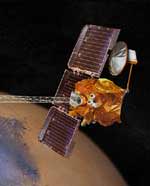
Image credit: NASA/JPL
During a recent solar storm, an instrument on board NASA’s Mars Odyssey spacecraft failed, and so far, operators haven’t been able to get it working again. The Martian Radiation Environment (MARIE) was designed to measure the radiation in the Martian space environment, which will help mission planners understand what kinds of risks humans might face if they traveled to the Red Planet. Operators will continue their attempts to get the instrument working for a few weeks before writing it off.
The martian radiation environment experiment on NASA?s 2001 Mars Odyssey orbiter has collected data continuously from the start of the Odyssey mapping mission in March 2002 until late last month. The instrument has successfully monitored space radiation to evaluate the risks to future Mars-bound astronauts. Its measurements are the first of their kind to be obtained during an interplanetary cruise and in orbit around another planet.
On Oct. 28, 2003, during a period of intense solar activity, the instrument stopped working properly. Controllers? efforts to restore the instrument to normal operations have not been successful. These efforts will continue for the next several weeks or months.
The martian radiation environment experiment detects energetic charged particles, including galactic cosmic rays and particles emitted by the Sun in coronal mass ejections. The dose equivalent from galactic cosmic rays as measured by the instrument agrees well with predictions based on modeling. Validation of radiation models is a crucial step in predicting radiation-related health risks for crews of future missions.
“Even if the instrument provides no additional data in the future, it has been a great success at characterizing the radiation environment that a crewed mission to Mars would need to anticipate,” said Dr. Jeffrey Plaut, project scientist for Mars Odyssey at NASA’s Jet Propulsion Laboratory, Pasadena, Calif.
JPL manages the Mars Odyssey and Global Surveyor missions for NASA’s Office of Space Science, Washington, D.C. Investigators at Arizona State University, Tempe; University of Arizona, Tucson; NASA’s Johnson Space Center, Houston; the Russian Aviation and Space Agency, Moscow; and Los Alamos National Laboratory, Los Alamos, N.M., built and operate Odyssey science instruments. Information about NASA’s Mars exploration program is available on the Internet at: http://mars.jpl.nasa.gov.
Original Source: NASA/JPL News Release
